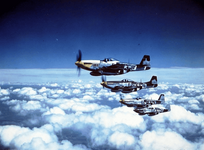Barrett
Senior Airman
The subject arose again in a couple of emails. Thought I'd share especially some members such as Bill Marshall can speak authoritatively.
http://www.wwiiaircraftperformance.org/mustang/P-51B_Fuselage_Tank_4-43-23-1.pdf
The 500+ lbs of 85 gals. fuselage fuel was accepted for an aft CG.
Notice 3.b comments
Confirms what one of my Iwo Jima sources (21st FG) said, "The P-51 with a full fuselage tank did not fly like anything resembling an airplane."
An ETO guy (55th FG) who loved the 38 called the 51 "The funny plane" for the same reason.
http://www.wwiiaircraftperformance.org/mustang/P-51B_Fuselage_Tank_4-43-23-1.pdf
The 500+ lbs of 85 gals. fuselage fuel was accepted for an aft CG.
Notice 3.b comments
Confirms what one of my Iwo Jima sources (21st FG) said, "The P-51 with a full fuselage tank did not fly like anything resembling an airplane."
An ETO guy (55th FG) who loved the 38 called the 51 "The funny plane" for the same reason.

